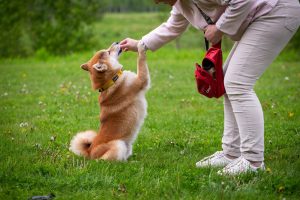We know that teaching your dog to come back is one of the most important things in dog training. Any responsible dog owner should know that. And it should be high on the dog training priority list, right there with sit and naming your dog.
But what you probably do not know is there are layers to recall. Today, we will talk about something even more challenging for your puppy to learn.
And that is the emergency recall.
Difference between regular and emergency recall
The trick here is your dog recognizes the difference between a cue/command that adds urgency and a regular cue and command.
It is better that you have both the regular recall and emergency recall. Why? Because there will be a situation where your dog is too distracted and not motivated enough to respond to a normal recall.
For example, when your dog is going after a squirrel, its brain becomes hyper-focused on chasing prey. At that point, your puppy might not even hear the word “come” or might not react to it.
But the emergency recall cue can solve that problem. What is the difference?
- When you teach emergency recall you do not fade out the high-value rewards
- You do not use a marker word or clicker when training emergency recall
- The reward is much more valuable to your puppy than regular recall reward. Think a jackpot, multiple treats in a row or something of higher value
- When your puppy learns it, do not use it for everyday situations, only for an emergency
What do you need for this cue?
The first thing you need for training an emergency recall is high-value rewards. Some dogs are motivated by food, which means high-value treats. Think chicken, cheese, or something like that. You can try some freeze-dried raw dog treats.
The moment you start using these high-value treats your dog knows something is different. So, do not use this reward for anything else other than practicing emergency recall.
Now, choose a word you do not speak often. One that is not part of your everyday life. It doesn’t have to be something like “come”. You can even try words like boomerang, airplane, or who knows what more. If you do not whistle after your dog, a whistle is also a good option for emergency recall.
How to train it?
Now let’s talk about the step-by-step guide on how to train emergency recall.
Step 1 – New Cue
Start by changing the verbal cue. If your cue is something like “bonanza”, say it, and give your dog 10 to 15 seconds of constant jackpot reward. To put it simply, small bites of a special treat. Pair it with excitement and verbal praise. Then, give your puppy a release cue like “Okay” or “free”.
Wait for 30 to 60 seconds and then repeat it. Practice it every day for a week, or until your puppy shows an immediate response to the word.
Step 2 – Add distance
Now once your puppy starts reacting to the emergency recall word “bonanza” to predict an amazing reward, it is time to add some distance.
In the beginning, make it a short distance, like 5 to 10 feet. Give the verbal cue for emergency recall. Make sure to stay consistent with the cue.
Slowly work on adding more and more distance. Do not move too far away too quickly. Yes, you might have a smart dog, but do not push it. Moving too far quickly will set the cue up for failure.
Mix up the sides when you want your puppy to come. Start in front, move to one side, and give the cue when you are behind your dog and everything in between. The goal here is to make your dog respond to the cue in any situation, no matter where you are.
Step 3 – Add Distractions
Now it is time to make it more challenging for your puppy. When your puppy gets classically conditioned to the cue, you can add layers and layers of difficulty.
We added distance, now it is time to add some distractions. Start with low-level distractions and increase the distance. Gradually increase distractions. Every time you increase the distraction level, reduce the distance, and then gradually increase distance with the existing distraction.
Practice on a long loose leash before you get to the off-leash part.
Now, this might sound like something you can get it done in a day or two. But it will take weeks, probably months before your puppy understands the concept of emergency recall.
Step 4 – Be consistent
Now it is just a matter of time to maintain the cue. You can practice it now and then, but do not overuse this cue. It is meant for an urgent situation only. That is why the emergency recall word has to retain the power to be reliable. If you overuse it, it becomes a regular recall.
How to encourage your dog to come to you?
Now that we talked about the basic obedience training and positive reinforcement training for emergency recall, let’s talk about some tips. How to encourage your puppy to come to you in an emergency situation? Here are some ideas:
- Make a distinctive noise, remember dogs are attracted to novel things, so talk in a super excited voice
- Run to the other direction as many dogs love to play chase to get their attention and focus on you
- Never run straight towards your dog, it makes your puppy the prey and they start running away from you
- Never practice recall in a high-distractions area like a dog park before you have it mastered
- Pretend you have found something of utmost importance and interest and make a big deal about it. Pretend there is food on the ground or something like that






